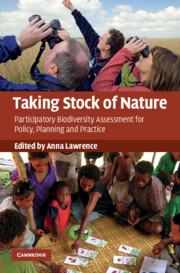Book contents
- Frontmatter
- Contents
- List of contributors
- Acknowledgements
- 1 Introduction: learning from experiences of participatory biodiversity assessment
- 2 Monitoring and assessment of biodiversity under the Convention on Biological Diversity and other international agreements
- 3 The Millennium Ecosystem Assessment: a multi-scale assessment for global stakeholders
- 4 Conservation of biological diversity in El Salvador shade coffee: the importance of taxonomic capacity for participatory assessments
- 5 Taking stock of nature in species-rich but economically poor areas: an emerging discipline of locally based monitoring
- 6 Researching local perspectives on biodiversity in tropical landscapes: lessons from ten case studies
- 7 Participatory resources monitoring in SW China: lessons after five years
- 8 Forest inventory in Nepal – technical power or social empowerment?
- 9 Perceptions of landscape change in British Columbia's Northwest: implications for biodiversity and participatory management
- 10 How thousands planned for a billion: lessons from India on decentralized, participatory planning
- 11 Inside monitoring: a comparison of bird monitoring groups in Slovenia and the United Kingdom
- 12 The personal and political of volunteers' data: towards a national biodiversity database for the UK
- 13 Improving forest management through participatory monitoring: a comparative case study of four community-based forestry organizations in the Western United States
- Index
- References
3 - The Millennium Ecosystem Assessment: a multi-scale assessment for global stakeholders
Published online by Cambridge University Press: 06 December 2010
- Frontmatter
- Contents
- List of contributors
- Acknowledgements
- 1 Introduction: learning from experiences of participatory biodiversity assessment
- 2 Monitoring and assessment of biodiversity under the Convention on Biological Diversity and other international agreements
- 3 The Millennium Ecosystem Assessment: a multi-scale assessment for global stakeholders
- 4 Conservation of biological diversity in El Salvador shade coffee: the importance of taxonomic capacity for participatory assessments
- 5 Taking stock of nature in species-rich but economically poor areas: an emerging discipline of locally based monitoring
- 6 Researching local perspectives on biodiversity in tropical landscapes: lessons from ten case studies
- 7 Participatory resources monitoring in SW China: lessons after five years
- 8 Forest inventory in Nepal – technical power or social empowerment?
- 9 Perceptions of landscape change in British Columbia's Northwest: implications for biodiversity and participatory management
- 10 How thousands planned for a billion: lessons from India on decentralized, participatory planning
- 11 Inside monitoring: a comparison of bird monitoring groups in Slovenia and the United Kingdom
- 12 The personal and political of volunteers' data: towards a national biodiversity database for the UK
- 13 Improving forest management through participatory monitoring: a comparative case study of four community-based forestry organizations in the Western United States
- Index
- References
Summary
Introduction
Government requests for information about the implications of ecosystem change for achieving social and economic goals piled up in the wake of four international environmental conventions, leading researchers and policy advisers to conduct ‘one of the most ambitious ecological studies’ to date, the Millennium Ecosystem Assessment (MA) between 2001 and 2005 (Tallis and Kareiva, 2006a). The aim was to assess the consequences of ecosystem change for human well-being and to establish the scientific basis for actions needed to enhance the conservation and sustainable use of ecosystems. Principle users were the international environmental conventions, such as the Convention on Biological Diversity (CBD), but the multi-disciplinary group of assessment leaders designed it to also meet the needs of the business community, the health sector, non-governmental organizations, and indigenous peoples. About 1300 participants contributed to the process as authors, and the end products included technical reports and summaries aimed at specific user groups.1
The MA was conceived as a multi-scale assessment, with interlinked assessments undertaken at local, watershed, national, regional, and global scales. Thus, in addition to providing global-scale information, 33 subglobal assessments aimed to meet the information needs of users2 in the regions where they were undertaken. By conducting the assessment at multiple scales, the assessment team hoped to both improve the quality of information and increase the relevance of the findings for decision-makers working at different levels of governance (Zermoglio et al., 2005; Wilbanks, 2006).
- Type
- Chapter
- Information
- Taking Stock of NatureParticipatory Biodiversity Assessment for Policy, Planning and Practice, pp. 49 - 68Publisher: Cambridge University PressPrint publication year: 2010
References
- 1
- Cited by



